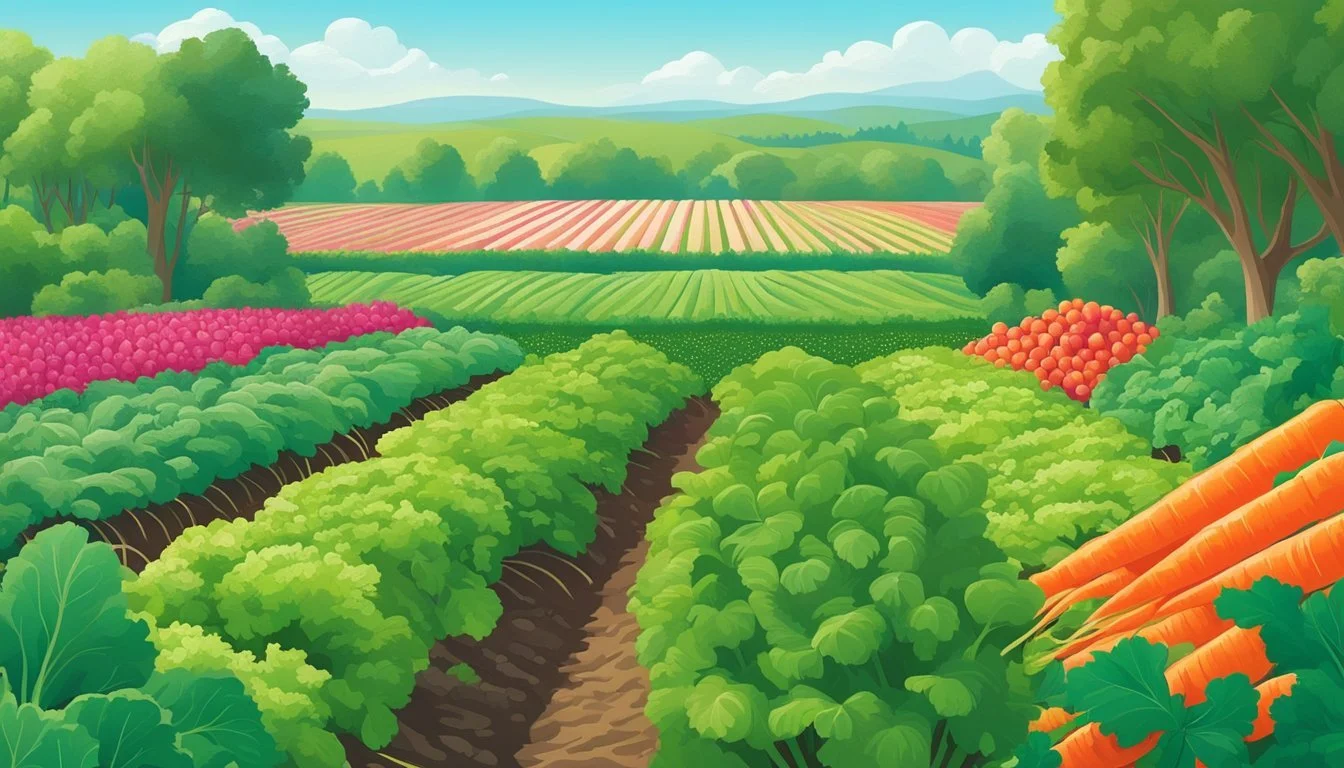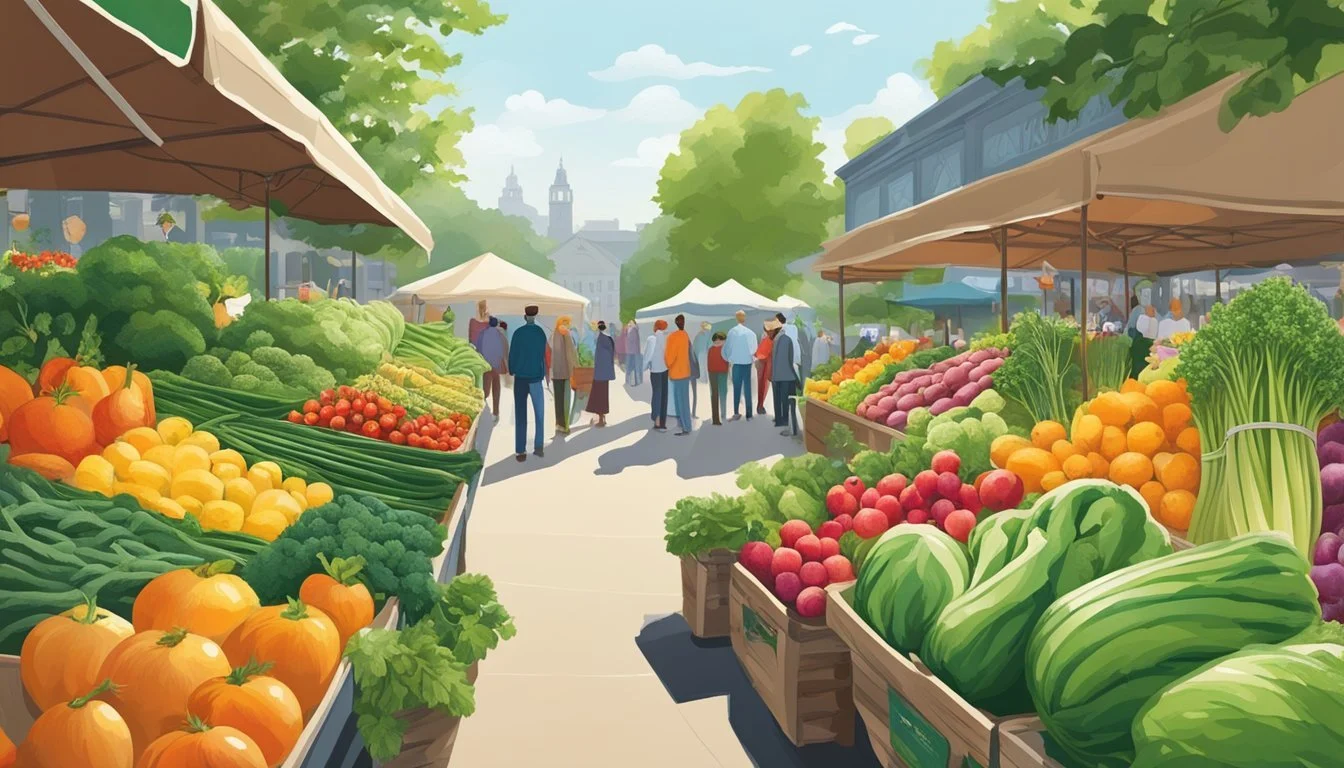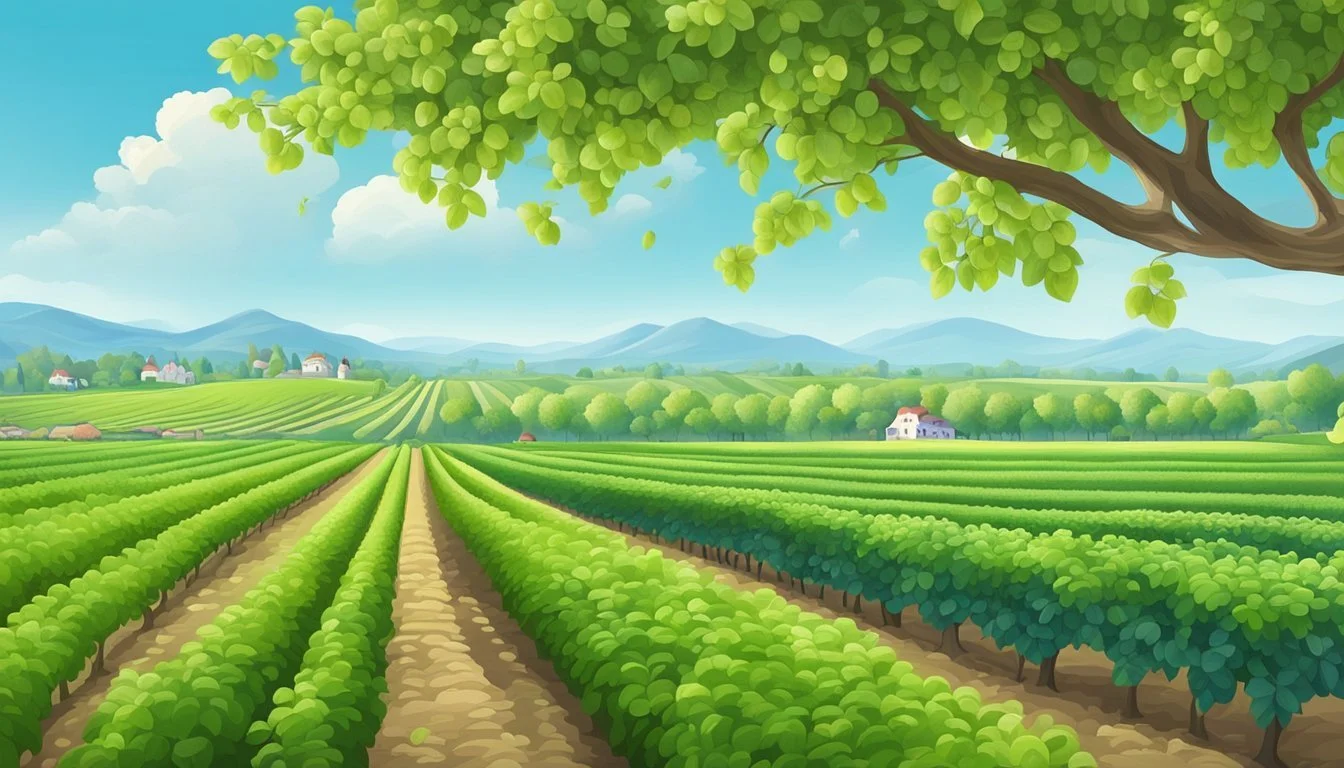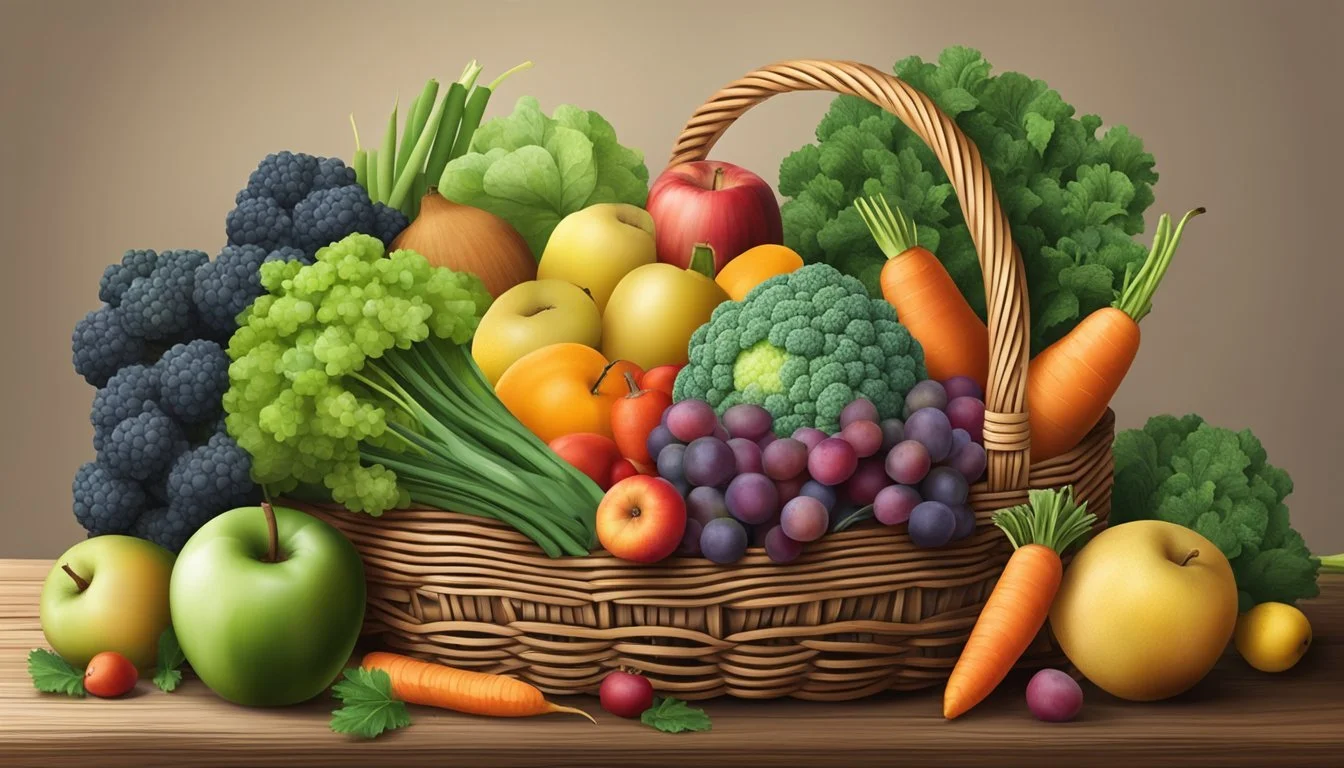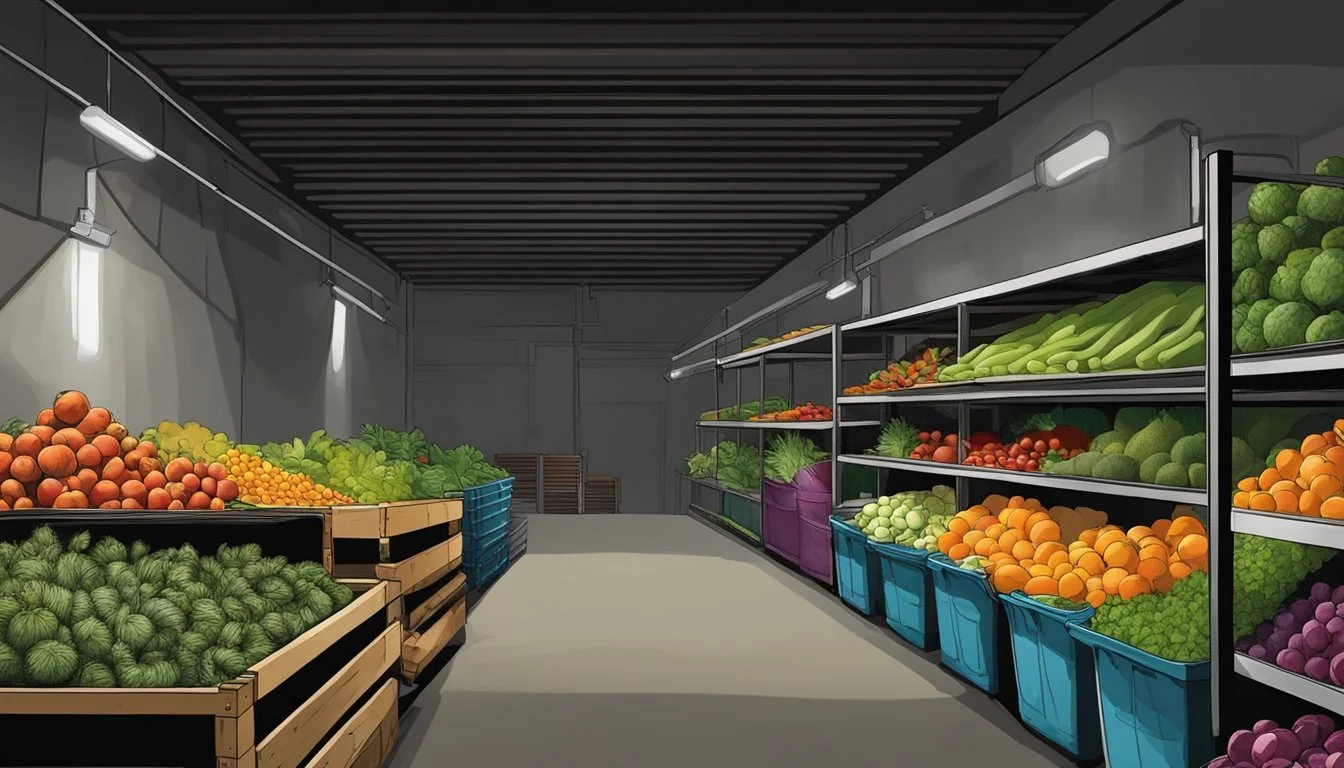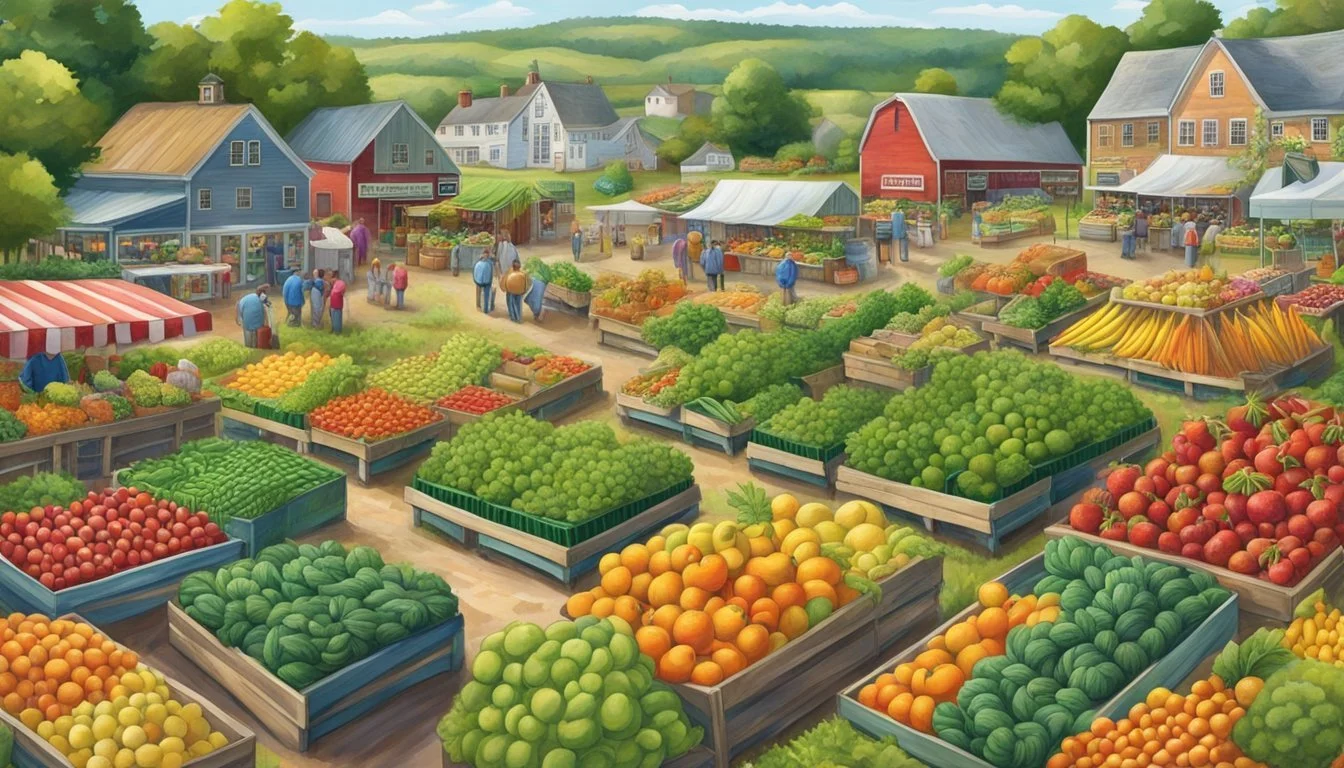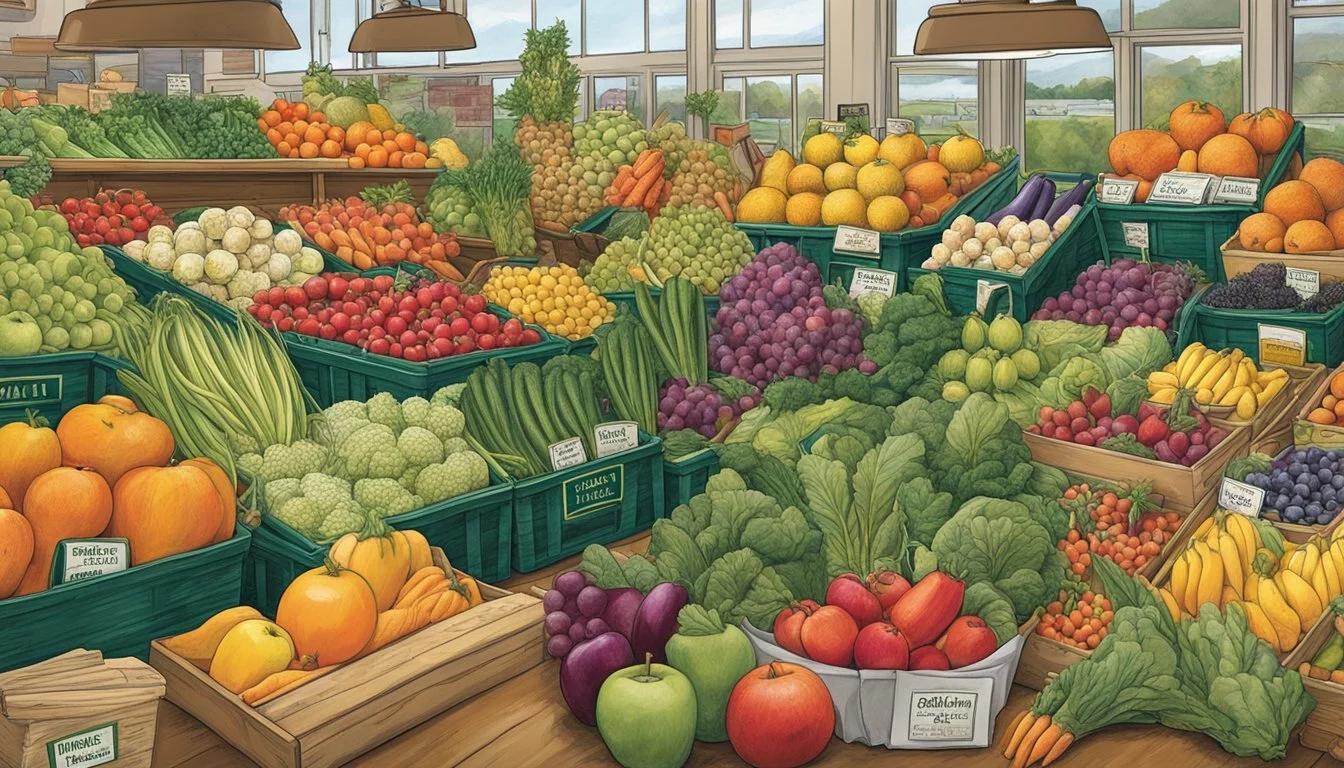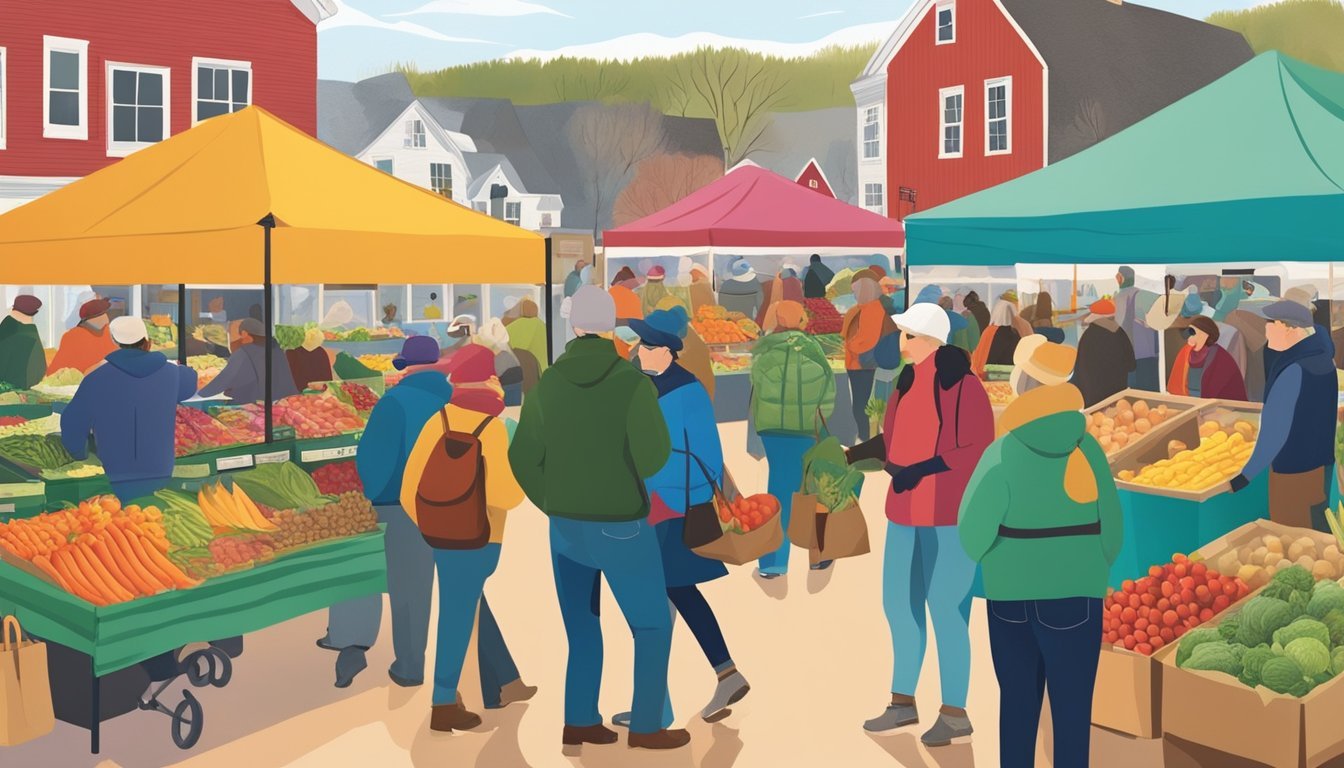Maine Seasonal Fruit & Vegetables in March
Your Fresh Guide
This Article is Part of our Maine Seasonal Fruit & Veg Calendar
Seasonal eating in Maine offers a unique palate of flavors, particularly due to the state's diverse climate and soil conditions. March in Maine is a transition period where the last vestiges of winter weather give way to the emerging signs of spring. Despite the growing anticipation for warmer days, the availability of local produce remains dictated by the tail end of cold temperatures and the preparation for the upcoming growing season.
During this month, consumers can typically find storage crops and hearty winter vegetables still holding strong in local markets and farms. Root vegetables such as beets, carrots (how long do carrots last?), and potatoes continue to be readily available, offering rich, earthy flavors (What wine goes well with earthy flavors?) that have been a staple throughout the wintry months. These vegetables, stored from the previous harvest, are complemented by the persistent production of hardy greens, which can survive Maine's chilly temperatures.
Maine farmers are also known for their resourcefulness in extending the seasonal availability of certain crops using techniques like greenhouse growing and cold storage. This means that even in March, with the persistent cold climate, there can be a limited supply of items like apples and cabbages. The widespread use of these agricultural practices ensures that local produce remains a part of the Maine diet as the state awaits the full bloom of spring.
Seasonal Overview
March in Maine marks the transition from the cold clutches of winter to the first hints of spring. Farmers and consumers alike anticipate this shift, as it signals a period of renewal for the agriculture sector. Given Maine's extended winter season, the month's offerings still gravitate towards hearty and robust produce. The agricultural landscape is largely dominated by storage crops and hearty winter greens that have been preserved to last through the colder months.
Vegetables: Root vegetables, such as potatoes, carrots, and turnips, are widely available, offering rich and earthy flavors ideal for comforting and nutritious meals. These items, stored from previous harvests, retain their quality and nutritional value.
Greens: While fresh, tender greens are not yet prolific, certain winter-hardy varieties may be found. These are typically grown in protected environments like greenhouses or cold frames. Kale and spinach are common examples, valued for their resilience and nutritional content.
Fruits: Fresh, locally-grown fruits are scarce during this time, yet some apples from cold storage may still be enjoyed. These apples, while not recently harvested, maintain a crisp texture and a sweet-tart flavor, suitable for eating raw or incorporating into baked dishes.
Farmers' markets and local food co-ops may have a selection of these fruits and vegetables. Preserved goods such as jams, pickles, and fermented products made from the previous season's bounty also remain staples at these venues in March. They underscore Maine's commitment to extending the availability of seasonal flavors year-round.
As the month progresses, the selections will slowly start to burgeon as the days lengthen, offering a precursor to the diverse abundance that spring will soon provide.
Fruit Availability in March
In March, the range of fresh local fruits in Maine is narrow due to the cold climate. Root vegetables and preserved crops typically dominate this season, but some hearty fruits like apples and pears are often still available, primarily through cold storage methods.
Apples
Apples remain a staple even in March, as they store well and retain quality for several months when kept in controlled environments. Consumers can expect to find varieties that are suited to long-term storage, offering crisp and tart flavors well-suited for both eating fresh and culinary applications.
Pears
Similarly, Pears may be available, also thanks to storage techniques. The selection is more limited and they may not be as commonly found as apples. The pears that are available are usually of varieties that are firmer and hold up well during storage, such as Bosc or Anjou. They are often best used where a little bit of texture in the fruit is desirable, like in baking or poaching.
Vegetable Harvest: Early Spring
In March, Maine's cold-adapted vegetables such as broccoli, cabbage, and carrots are typically available and are harvested by local farmers who use season extension techniques.
Broccoli
In early spring, broccoli thrives in Maine's cool temperatures. Typically, these vegetables have been overwintered or grown in greenhouses, and are ready for harvest in March. Available: Fresh broccoli is typically accessible from farmers markets and local producers during this period.
Cabbage
Cabbage is a hardy vegetable that can withstand the chilly Maine winter, making it another staple of the early spring harvest. It's harvested when the heads reach a sufficient size and firmness. Availability: Look for a range of cabbage at local markets, with green varieties being most common.
Carrots
Carrots that were planted in the previous fall can often be harvested in March as the ground thaws. They tend to be sweeter this time of year due to the concentration of sugars after a frost. Harvested: Farmers may have storage varieties available as well, which were harvested in the fall and kept in cold storage over the winter.
Leafy Greens and Herbs
In March, Maine's cooler climate favors hearty leafy greens and robust herbs. These nutritional powerhouses are not only versatile in the kitchen but also resilient to the state's lingering winter chill.
Kale
Kale thrives in cooler temperatures, making it plentiful during Maine's early spring. This nutrient-dense green is often available at local farmers' markets and grocers. Consumers can enjoy it raw in salads or sautéed as a warming side dish.
Spinach
Another cold-hardy green, spinach, maintains its tender leaves despite the cool March weather. Its versatility allows it to be used in a myriad of dishes, from fresh salads to hearty baked foods, ensuring its availability is consistent throughout the season.
Parsley
Parsley, a cold-tolerant herb, is often found fresh in Maine during March. It provides a burst of flavor and color to a variety of dishes. Chefs and home cooks alike utilize its vibrant taste to enhance soups, stews, and garnishes.
Seasonal Roots and Tubers
March in Maine finds winter transitioning slowly into spring, and with it comes the opportunity to enjoy a variety of hearty roots and tubers that are available. These vegetables play a fundamental role in the local diet, given their ability to be stored and remain fresh throughout the colder months.
Potatoes
Maine's cultivation of potatoes thrives in its northern regions, with the state being renowned for its high-quality crop. During March, storage capabilities ensure that a diverse array of potatoes is available, from starchy russets ideal for baking to creamy reds perfect for mashing. Potatoes remain a staple, as they are resilient through the winter season.
Turnips
Turnips, a versatile root, can be both eaten raw in salads or cooked to complement hearty meals. They maintain their availability in March and offer a slightly peppery taste that distinguishes them from other root vegetables. Despite being less celebrated than other roots, turnips provide significant nutritional value and cultural importance in traditional Maine dishes.
Parsnips
Characterized by their sweet and earthy flavor, parsnips are typically at the end of their availability in March. Although similar in appearance to white carrots, they hold their own with a unique taste and texture that elevates winter soups and roasts. Parsnips, when roasted, can develop an intense sweetness that is highly appreciated by chefs and home cooks alike.
Planning and Preparation
March in Maine marks a transitional period where winter's grip begins to ease and preparations for spring are underway. While the selection of fresh produce is more limited compared to the bountiful summer months, diligent planning and preparation ensure a smooth transition and availability of seasonal fruits and vegetables.
Farmers and gardeners utilize this time for planning their crop rotations and preparing their soil. They might amend their soil with compost or other organic matter to enrich it after a long winter. This is also the ideal time to start seedlings indoors for crops like tomatoes and peppers, which require a longer growing season.
Mainers who visit farmers’ markets can expect to find storage crops from the previous fall alongside early spring harvests. This selection often includes:
Root Vegetables: carrots, beets, and parsnips
Alliums: onions and garlic
Hearty Greens: kale and spinach
Herbs: such as parsley and thyme
Farmers employ season extension techniques, like high tunnels and cold frames, to provide these early greens. These methods allow them to defy the cold climate to some extent by capturing solar energy and creating microenvironments that are more hospitable for growing.
For those planting at home, March is the right time to prepare garden beds by clearing out any debris from the previous season and planning where each plant will go, considering the needs for sunlight and soil type. They should also be aware of the last frost date and use it to determine the optimal time for transplanting seedlings outdoors.
In summary, March in Maine is a time of readiness for both farmers and consumers, looking forward to the growing season with anticipation.
Seasonal Recipes and Usage
March in Maine is a transitional month, whereby the tail end of winter produce meshes with the early signs of spring. The availability of certain fruits and vegetables during this time inspires a range of recipes that are both nutritious and harmonious with the seasonal palette.
Fruits: While the variety of fruits in March is not as abundant as in the summer months, apples remain a staple, often stored from the fall harvest and still retaining their crisp texture and flavor. They can be used in baked goods, such as pies and muffins, or sliced raw for fresh salads.
Vegetables: Root vegetables like carrots, beets, and potatoes continue to be readily available and are ideal for hearty stews and roasts. These dishes not only provide comfort during the waning cold days but also offer a significant nutritional boost.
Vegetable Suggested Usage Carrots Glazed, roasted, or in soups Beets Pickled, salads, or roasted Potatoes Mashed, roasted, or in potato pancakes
In addition to these, Mainers enjoy the early harvest of microgreens and mushrooms, which are perfect for adding a fresh, earthy flavor to any dish. Microgreens make excellent garnishes or additions to sandwiches, while mushrooms can be sautéed or incorporated into omelets and pasta (how long does pasta last?) dishes.
Among the most awaited seasonal foods in March are maple products, as maple tapping season begins. Maple syrup (how long does maple syrup last?) can be used as a natural sweetener in a variety of recipes, from glazing root vegetables to enhancing the flavor of breakfast staples like oatmeal and pancakes.
As the snow melts and the soil thaws, Maine’s food landscape begins to change, offering a blend of winter's hearty roots and early spring's fresher tastes, allowing for creative and sustaining cuisine.
Storing and Preservation
In March, Maine residents typically focus on proper storage and preservation techniques for overwintered crops. Root vegetables, such as carrots, potatoes, and beets, are often kept in root cellars where the environment is cool and humid. This allows these hardy crops to remain fresh for consumption or sale well into the spring season. Residents ensure these vegetables are spaced out and not touching to prevent spoilage.
For preservation of seasonal produce, freezing is a common method. Individuals carefully blanch vegetables before freezing to maintain quality and nutrition. This is suitable for fruit available during the previous seasons and stored for later use. Items like berries are washed, dried, and placed on trays to freeze individually before being stored in freezer bags to avoid clumping.
Canning provides another avenue for long-term storage, following detailed guidelines to ensure safety. The University of Maine and the USDA provide resources on canning practices, which include sterilizing jars and following precise timing to preserve the color and texture of produce. This method is especially useful when there is an abundance of a particular fruit or vegetable.
The practice of preservation in Maine is particularly important as it allows residents to enjoy local produce outside the typical growing seasons. With proper storage and preservation, they capture the essence of each season's harvest, ensuring a continuous supply of nutritional food throughout the year.
Local Agriculture and Markets
In March, Maine's local agriculture showcases the resilience of farmers who adeptly navigate the cooler temperatures. At this time, most farmers' markets are preparing for the spring season, while year-round vendors still provide a variety of produce.
Seasonal Availability:
Customers can expect a selection of fruits and vegetables that store well through the winter or are grown in cold-hardy conditions. For instance:
Stored Fruits and Vegetables:
Apples (stored from fall harvest)
Potatoes
Carrots
Cold-Hardy Produce:
Greens (such as kale and spinach)
Root vegetables like turnips and beets
Although the range is more limited compared to the peak growing season, these offerings are cherished for their local origin and freshness. Maine's farmers' markets, such as those operating in larger towns and cities, continue to foster community connections and support food security through the colder months.
Local Markets' Role:
These markets serve as vital outlets for farmers to distribute their goods and for residents to access fresh produce. Seasonal operations adjust schedules and offerings, emphasizing the importance of supporting local even during the off-peak times. Farmers and producers adapt by utilizing greenhouses or cold frames to extend the growing season for certain crops.
The dedication of local farmers ensures that even in March, Maine's markets have fresh, seasonal produce available for consumers looking for high-quality, locally-sourced food.
Nutrition and Health Benefits
In March, residents of Maine can benefit greatly from the seasonal produce available. Many fruits and vegetables harvested during this time are not just fresh but also packed with vital nutrients beneficial to health.
Fruits and berries available in March are often high in antioxidants, vitamins, and fiber. Antioxidants play a crucial role in combating free radicals, which can damage cells and lead to various health issues. The fiber found in fruits aids in digestion and can help maintain a healthy weight.
Vegetables, such as leafy greens, are abundant in March and offer a wealth of health advantages. They typically contain high levels of vitamins, including Vitamin K, which is essential for bone health and proper blood clotting. Vegetables also provide significant amounts of dietary fiber, which is important for gut health.
Leafy greens like arugula, not only are rich in flavor but also in nutritional value. They contain vitamins and minerals, including folate, which is necessary for cell growth and metabolism.
Nutrient Benefit Antioxidants Protect cells from damage Vitamin K Supports bone health and blood clotting Folate Crucial for cell growth and metabolism Dietary Fiber Enhances digestive health and weight management
Eating a variety of seasonal produce ensures one gets a spectrum of nutrients. The availability of seasonal fruits and vegetables in March can contribute to an individual's overall health, supporting the immune system, and promoting a healthy lifestyle. Moreover, opting for local and in-season items not only supports Maine's farmers but also ensures peak flavor and nutritional content.
Environmental Impact and Sustainability
In Maine, the emphasis on seasonal fruit and vegetable production directly correlates with environmental sustainability efforts. Seasonal consumption significantly reduces the carbon footprint associated with long-distance food transport and often means a reduction in the energy consumed for storage and preservation. Local farmers play a pivotal role in this process, providing an array of produce that aligns with Maine's seasonal offerings, thereby promoting a more sustainable food system.
Spring offerings in Maine tend to include cold-tolerant crops. Here's a shortlist of available fruits and vegetables in March:
Apples (stored from fall)
Root vegetables (like beets and carrots from storage or late winter harvest)
Leafy greens (from greenhouses)
These items typically require less energy-intensive methods to grow during the colder months compared to non-seasonal produce that might necessitate heated greenhouses or importation.
Moreover, the environmental impact is further mitigated by the reduced need for packaging and processing, since local distribution channels are shorter and often involve selling directly to consumers through farmers' markets or community-supported agriculture (CSA) programs.
The practice of consuming seasonally also supports Maine's farmers, as it keeps resources within the local economy and encourages sustainable agriculture practices. This support helps ensure that farmers can continue their environmentally-friendly approaches, like crop rotation and organic farming, which are beneficial to soil health and biodiversity.
Thus, incorporating seasonal fruits and vegetables into the diet is not a mere trend but a conscious choice by Mainers to reduce environmental impact and advocate for a sustainable future in agriculture.
Conclusion
In March, residents and visitors in Maine have the opportunity to access a variety of seasonal fruits and vegetables. Despite the chilly beginnings of spring in the region, one can find a selection of produce that is both fresh and flavorful.
The following fruits and vegetables are typically available during this period:
Apples: Stored from fall harvest and still crisp.
Beets: Offering earthy flavors, a staple through the cold months.
Cabbage: Hardy and versatile for a range of dishes.
Carrots: Sweet, rich, and perfect for both raw and cooked applications.
Garlic: Essential for cooking, available storage crops provide strong flavor.
Local farmers' markets continue to supply these items, thanks to the efforts to extend seasonality and indoor growing practices. Consumers can rely on these foods to be part of their March meals, supporting local agriculture and benefiting from the nutritional richness of in-season produce.
It is important for consumers to engage with local vendors, as some may offer additional items based on innovative farming techniques that push the boundaries of the traditional growing calendar. These relationships can also provide insights into the best uses of these seasonal ingredients, ensuring that the culinary experiences in Maine remain exceptional throughout the year.




